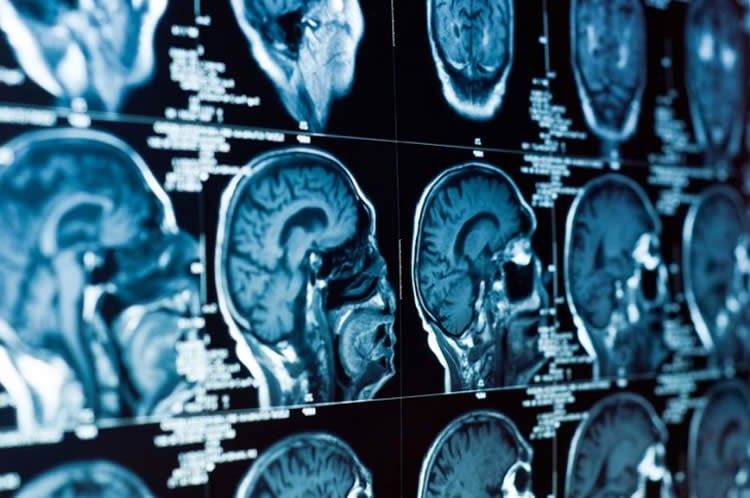Damage in specific brain structures has been found to be associated with a greater risk of depressive symptoms in late life according to research from the University of Aberdeen.
Data gathered from the Aberdeen Birth Cohort of 1936, was used to find how depressive symptoms are linked with localised brain damage and if intelligence and physical fitness have an effect on the presentation of depressive symptoms.
Professor of Radiology, Alison Murray used Magnetic Resonance Imaging (MRI) and complex statistical modelling to find the link between areas of brain damage, intelligence, physical fitness and depressive symptoms in a study published in Archives of Gerentology and Geriatrics.
The MRI scans were used to identify the location of brain lesions – areas of brain damage, usually indicative of blood vessel disease in the brain – and it was found that if the lesions were found in deep brain structures, the individual affected was more likely to have depressive symptoms than if the damage was anywhere else.
However, it was found that higher levels of intelligence and better physical fitness reduced the risk of depressive symptoms even in people with deep brain lesions.
Professor Murray said: “Our results confirmed previous findings that lesions predict depressive symptoms, but we went a step further to show that the presentation of depressive symptoms depends on where the lesions are in the brain.
“We found that if the lesions involve deep structures in the brain they are more likely to be associated with depressive symptoms. Whereas, if they are in the brain stem and cerebellum, people are more likely to be physically impaired.
“In addition to this, we found that people with higher intelligence and better physical health are protected from the depressive symptoms associated with these lesions. This supports the whole concept that exercise is good for brain and mood and can reduce depressive symptoms.

“In terms of practical applications, this research means that in the future, we can use this information to identify and those at greater risk of depressive symptoms and in doing so target appropriate people to treat.”
“We are extremely grateful to Aberdeen birth cohort participants for giving up their time to help us understand major health problems like depression.
“This is the first study that has determined what symptoms people are likely to experience depending on where lesions are.
Source: Wendy Skene – University of Aberdeen
Image Source: Image is adapted from the University of Aberdeen press release.
Original Research: Abstract for “Brain hyperintensity location determines outcome in the triad of impaired cognition, physical health and depressive symptoms: A cohort study in late life” by Alison Murray, Chris McNeil, Sima Salarirad, Ian Deary, Louise Phillips, Lawrence Whalley, and Roger Staff in Archives of Gerentology and Geriatrics. Published online October 19 2015 doi:10.1016/j.archger.2015.10.004
Abstract
Brain hyperintensity location determines outcome in the triad of impaired cognition, physical health and depressive symptoms: A cohort study in late life
Purpose of the study
Brain hyperintensities, detectable with MRI, increase with age. They are associated with a triad of impairment in cognitive ability, depression and physical health. Here we test the hypothesis that the association between hyperintensities and cognitive ability, physical health and depressive symptoms depends on lesion location.
Design and methods
244 members of the Aberdeen 1936 Birth Cohort were recruited to this study. 227 participants completed brain MRI and their hyperintensities were scored using Scheltens’s scale. 205 had complete imaging, cognitive, physical health and depressive symptom score data. The relationships between hyperintensity location and depressive symptoms, cognitive ability and physical health were examined by correlation and structural equation analysis.
Results
We found that depressive symptoms correlated with hyperintensity burden in the grey matter (r = 0.14, p = 0.04) and infratentorial regions (r = 0.17, p = 0.01). Infratentorial hyperintensities correlated with reduced peak expiratory flow rate (r = −0.26, p < 0.001) and impaired gait (r = 0.13, p = 0.05). No relationship was found between white matter and periventricular (supratentoral) hyperintensities and depressive symptoms. Hyperintensities in the supratentorial and infratentorial regions were associated with reduced cognitive performance. Using structural equation modelling we found that the association between hyperintensities and depressive symptoms was mediated by negative effects on physical health and cognitive ability.
Conclusions
Hyperintensities in deep brain structures are associated with depressive symptoms, mediated via impaired physical health and cognitive ability. Participants with higher cognitive ability and better physical health are at lower risk of depressive symptoms.
“Brain hyperintensity location determines outcome in the triad of impaired cognition, physical health and depressive symptoms: A cohort study in late life” by Alison Murray, Chris McNeil, Sima Salarirad, Ian Deary, Louise Phillips, Lawrence Whalley, and Roger Staff in Archives of Gerentology and Geriatrics. Published online October 19 2015 doi:10.1016/j.archger.2015.10.004






